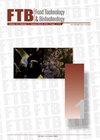超声波辅助微波封装蛋白多糖复合物中的花生油的优化研究
IF 2.5
4区 农林科学
Q3 BIOTECHNOLOGY & APPLIED MICROBIOLOGY
引用次数: 0
摘要
研究背景。花生油(Arachis hypogaea L.)是不饱和脂肪酸的丰富来源。据报道,食用花生油对人体健康有生物学影响。花生油中的不饱和脂肪酸,尤其是多不饱和脂肪酸(PUFA)极易氧化,从而在加工和储存过程中形成有害化合物。研究的目的是利用微波干燥工艺将花生油中的 PUFA 包裹在蛋白质-多糖复合物中,防止其氧化。实验方法评估了玉米淀粉(CS)和乳清蛋白分离物(WPI)在超声波辅助微波封装花生油以防止氧化降解方面的组合效果。采用响应面方法(RSM)评估了独立参数,即 CS:WPI 比例(1:1 至 5:1)、卵磷脂(0-5%)、超声(0-10 分钟)和微波功率(150-750 瓦)对封装花生油的影响。记录并分析了工艺反应,即乳化液的粘度和稳定性、封装效率、过氧化值、抗氧化活性、游离脂肪酸(FFA)、水分、休止角和流动性(豪斯纳比率 HR 和卡尔指数 CI),以优化自变量。用超声波法制备的用于封装的所有乳液的粘度在 6.90 至 14.40 cP 之间,7 天内的稳定性超过 90%。观察到封装花生油的封装效率为 21.82-74.25%。封装效率受 CS:WPI 比例和超声波处理的影响很大。过氧化值、抗氧化活性和 FFA 分别为 1.789-3.723 mg/kg、19.81-72.62 % 和 0.042-0.127 %。水分含量、静止角、HR 和 CI 等物理性质分别为 1.94-8.70%(重量比)、46.5-58.3⁰、1.117-1.246 和 10.48-22.14%。封装物的表面特性对其物理性质有很大影响。在 CS:WPI 比例为 1.25、卵磷脂含量为 0.25%、超声时间为 9.99 分钟、微波功率为 355.41 W 的优化条件下,花生油的包封效率较高(74.25%)。该研究结果为食品科学与技术领域提供了一种实用的方法,通过封装来保持花生油的营养质量并提高其稳定性,从而促进其对消费者的潜在健康益处,并应用于乳制品和烘焙等多个行业。本文章由计算机程序翻译,如有差异,请以英文原文为准。
Optimization of Ultrasound-Assisted Microwave Encapsulation of Peanut Oil in Protein-Polysaccharide Complex
Research background. Peanut oil (Arachis hypogaea L.) is a rich source of unsaturated fatty acids. Consumption of peanut oil has been reported to have biological effects on human health. Unsaturated, especially poly-unsaturated fatty acids (PUFA), found in peanut oil are highly susceptible to oxidation, resulting in the formation of noxious compounds during processing and storage. The aim was to prevent peanut oil PUFA from oxidation by encapsulation in a protein-polysaccharide complex using the microwave drying process.
Experimental approach. The combination effect of corn starch (CS) and whey protein isolate (WPI) was evaluated for ultrasound assisted microwave encapsulation of peanut oil to prevent oxidative degradation. The effect of independent parameters, viz. CS:WPI ratio (1:1 to 5:1), lecithin (0–5 %), ultrasonication (0–10 min) and microwave power (150–750 W) on encapsulation of peanut oil was evaluated using response surface methodology (RSM). The process responses viz., viscosity and stability of emulsion, encapsulation efficiency, peroxides value, antioxidant activity, free fatty acids (FFA), moisture, angle of repose and flowability (Hausner ratio, HR and Carr’s Index, CI) were recorded and analysed to optimize the independent variables.
Results and conclusions. The viscosity of all the emulsions prepared for encapsulation by ultrasonication ranged 6.90 to 14.40 cP having more than 90 % stability over 7 days. The observed encapsulation efficiency was 21.82–74.25 % for encapsulated peanut oil. Encapsulation efficiency was significantly affected by CS:WPI ratio and ultrasonication. The peroxide value, antioxidant activity and FFA ranged between 1.789–3.723 mg/kg oil, 19.81–72.62 % and 0.042–0.127 %, respectively. Physical properties such as moisture content, angle of repose, HR and CI was observed 1.94–8.70 % (w.b.), 46.5–58.3⁰, 1.117–1.246 and 10.48–22.14 %, respectively. The physical properties were significantly affected by surface characteristics of the encapsulates. The higher efficiency (74.25 %) of the peanut oil encapsulation could be achieved at optimized condition of 1.25 CS:WPI ratio, 0.25 % lecithin, 9.99 min ultrasonication and 355.41 W microwave power.
Novelty and scientific contribution. The findings contribute to the fields of food science and technology by offering a practical approach to preserving the nutritional quality of peanut oil and enhancing its stability by encapsulation, thereby promoting its potential health benefits for consumers and applications in various industries such as dairy and bakery.
求助全文
通过发布文献求助,成功后即可免费获取论文全文。
去求助
来源期刊

Food Technology and Biotechnology
工程技术-生物工程与应用微生物
CiteScore
3.70
自引率
0.00%
发文量
33
审稿时长
12 months
期刊介绍:
Food Technology and Biotechnology (FTB) is a diamond open access, peer-reviewed international quarterly scientific journal that publishes papers covering a wide range of topics, including molecular biology, genetic engineering, biochemistry, microbiology, biochemical engineering and biotechnological processing, food science, analysis of food ingredients and final products, food processing and technology, oenology and waste treatment.
The Journal is published by the University of Zagreb, Faculty of Food Technology and Biotechnology, Croatia. It is an official journal of Croatian Society of Biotechnology and Slovenian Microbiological Society, financed by the Croatian Ministry of Science and Education, and supported by the Croatian Academy of Sciences and Arts.
 求助内容:
求助内容: 应助结果提醒方式:
应助结果提醒方式:


